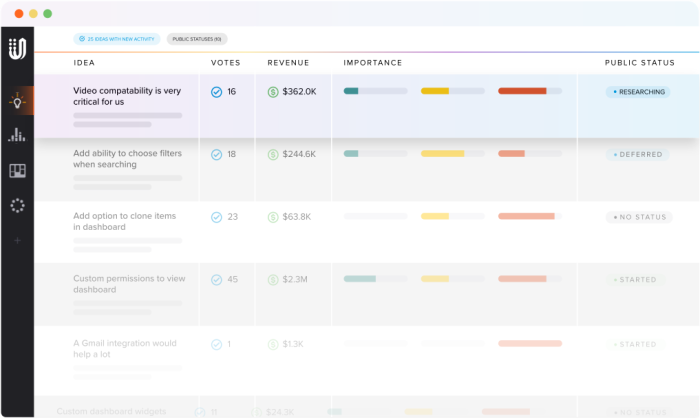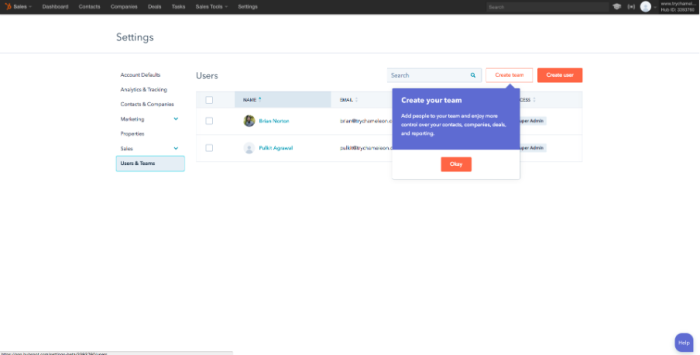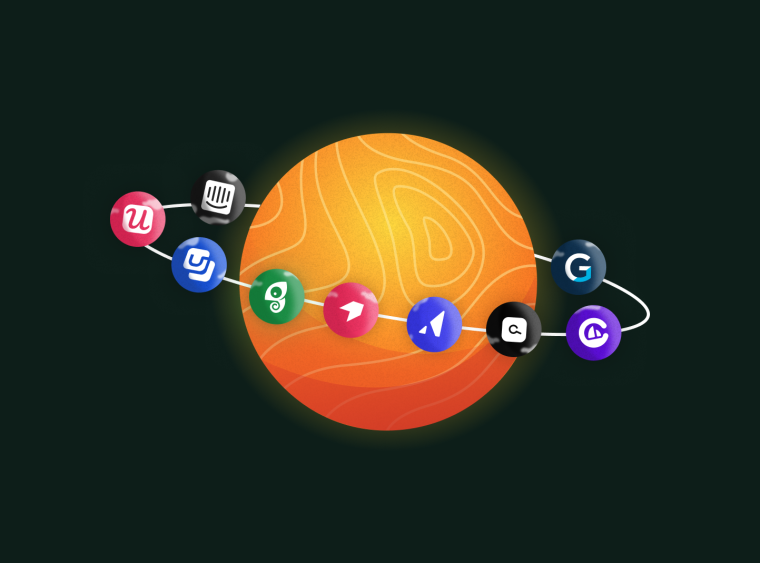Grabbing a customer’s attention can be easy. But keeping it? That’s where businesses struggle. Customers have options—too many, actually. If your brand isn’t engaging, they’ll move on, scrolling, clicking, or bouncing to a competitor.
The right customer engagement tools don’t just grab attention—they keep users interacting, coming back, and actually enjoying the experience. Whether it’s automation, personalization, or in-app nudges, the best customer engagement tools help you increase user engagement without spamming inboxes or annoying your audience.
In this guide, you’ll see proven user engagement strategies and real customer behavior and engagement examples to find out what works (and why). Let’s get into it!
The importance of increasing user engagement
User engagement is how actively and consistently people interact with your brand. It includes actions like clicking through emails, using your app, making repeat purchases, or engaging on social media.
That’s exactly why increasing user engagement matters—it fuels customer retention, loyalty, and revenue. Engaged users don’t just show up once and disappear—they come back, interact, and build a connection with your brand. The result? Higher retention rates, stronger brand loyalty, and more sales.
6 Top user engagement tools
Whether it’s in-app messaging, interactive tours, or real-time analytics, these customer engagement solutions help you create a seamless experience that keeps users coming back.
1. In-app messaging platforms
In-app messaging platforms help you communicate with users while they’re using your product—not later when they might ignore an email or swipe away a push notification. These messages show up in real time, making them perfect for onboarding, product announcements, feature adoption, and nudging users toward action.

For example, Chameleon does this well. The moment you log in, you’re greeted with a personalized welcome message and a dashboard showing key engagement insights. Need help? A floating help menu pops up in the corner, offering instant access to guides, updates, and a direct chat option. All of this makes it easy for users to find what they need without leaving the platform—at every stage in their customer journey.
2. Interactive guides and tours
If users don’t understand your product, they won’t stick around. Interactive guides and product tours solve this by showing, not just telling, users how to get value from your platform—right when they need it. Instead of static help docs or long onboarding emails, these tools offer step-by-step instructions inside your app, making learning effortless.

When Degreed redesigned its Learner Home, it needed to introduce 50,000 users to the new interface without overwhelming them. Instead of forcing a sudden switch, Degreed used Chameleon’s product tours and microsurveys to guide users through product changes at their own pace. In other words, they gave users the option to try the new design before it became permanent.
Here’s what they achieved:
280% increase in opt-ins for the beta platform
Fewer support tickets—users understood the changes before they rolled out
Continuous user feedback that shaped future product decisions
Want to see Chameleon in action? Try this interactive demo 👇
3. Push notification services
Sometimes, users need a little nudge to come back. Push notifications bring users back to your app or website by delivering timely, relevant messages straight to their devices. When done right, they increase user engagement without feeling intrusive.
“For an effective user engagement strategy, you need to understand when, at what stages, users interact with your tool, and what you can give them at these moments to push them further down the funnel.”
Push notifications help with:
✅ Re-engagement: Remind inactive users about your product
✅ Personalization: Send tailored updates based on user behavior
✅ Real-time alerts: Notify users about updates, deals, or time-sensitive actions
The key to push notifications is timing and relevance. As Yudin points out, context matters. If a push notification lands at the wrong time or feels generic, users will ignore it—or worse, disable notifications altogether.

Here are some notable push notification services:
Pushwoosh: A comprehensive platform offering cross-channel messaging, including push notifications, in-app messages, and emails. Pushwoosh provides advanced features like user segmentation, personalization, and high-speed delivery, enabling businesses to engage users effectively.
OneSignal: A widely-used service that allows businesses to send behavior-based push notifications, keeping users engaged with relevant updates.
Firebase Cloud Messaging (FCM): A free, scalable solution for mobile and web notifications, offering reliable message delivery and extensive integration capabilities.
4. Customer feedback tools
If you want to keep users engaged, you need to know what they actually think. Real insights come from listening to your users, understanding their pain points, and acting on their feedback. That’s where customer feedback tools come in.
Different feedback methods help capture user sentiment in real time and across various touchpoints:
1. Microsurveys (quick in-app feedback)

Microsurveys collect user feedback inside your product without disrupting the customer experience. They’re great for checking in on user satisfaction, feature adoption, or any friction points.
According to Chameleon's 2024 Benchmark Report, the average Microsurvey completion rate is 15%. Well-designed surveys with four response options can reach a 90% completion rate. This proves that keeping surveys short, relevant, and contextual is key to getting meaningful and valuable insights.
With Chameleon's no-code Microsurveys, anyone on your team can build, launch, and optimize surveys in minutes. Target users precisely based on plan type, role, or past responses, then trigger follow-ups based on sentiment.
And because feedback is only useful when it’s actionable, Chameleon integrates with tools like Slack, Mixpanel, and Intercom. You get instant insights, automatic data syncs, and a continuous feedback loop—without data silos.
2. Net Promoter Score® (NPS) surveys

NPS surveys measure how likely users are to recommend your product to others. They’re a key indicator of customer satisfaction and loyalty.
Delighted is a simple yet powerful tool for automating NPS surveys across email, SMS, and in-app channels. Its user-friendly interface is built for speed, allowing teams to start collecting feedback with minimal setup while delivering real-time insights. This makes it ideal for companies that want a no-fuss way to gauge customer sentiment at scale.
For businesses needing deeper analysis of customer data, Qualtrics takes NPS a step further with advanced sentiment tracking, response segmentation, and predictive analytics. It helps uncover patterns in customer feedback, making it easier to take proactive steps to improve loyalty and retention.
See how you can create a survey in Chameleon 👇
3. Feature request and feedback portals

These tools allow users to submit, upvote, and comment on feature requests—helping prioritize improvements based on real demand.
UserVoice streamlines feedback collection with a structured system that helps teams organize, rank, and respond to user requests. It’s built for businesses that need a scalable way to capture insights from multiple sources—customers, sales teams, and customer support reps—all in one place. With built-in prioritization features, it ensures that product decisions align with actual user needs, not just internal assumptions.
For a more transparent approach, Canny offers a public roadmap alongside its feedback portal, allowing users to track progress on feature requests. It helps teams close the loop by keeping customers informed about what’s in development and what’s coming next.
4. Session recordings and heatmaps

Sometimes, users don’t say what’s wrong—they show it. Heatmaps and session recordings help visualize user behavior and identify usability issues.
Hotjar is one of the most widely used tools for user behavior analytics, providing click, scroll, and movement heatmaps alongside session recordings to track how users navigate a site or app.
These insights help teams identify friction points, optimize layouts, and improve conversions. Hotjar’s suite of tools allows teams to focus on key customer interactions like drop-offs or hesitation on checkout pages. With real-time visual data, businesses can move beyond assumptions and make changes based on how users actually engage with their products.
5. Email marketing automation
Email may be old-school, but it still works—when done right. The key to increasing user engagement is making sure emails land at the right moment—not when users have already lost interest.
“For each stage of the funnel, you need to understand: What to talk about with the user, how to personalize your message, and how to maximize your product value for the user.”
Here’s how automated email campaigns help:
✅ Onboarding sequences: Guide new users step-by-step to get the most out of your product
✅ Behavior-based emails: Remind users to complete an action, like finishing a setup or revisiting a feature
✅ Re-engagement marketing campaigns: Bring back inactive users with personalized incentives or helpful content

HubSpot offers advanced workflows designed for lead nurturing and customer retention. With its drag-and-drop automation builder, teams can set up complex email sequences triggered by user actions, ensuring every message is relevant and well-timed. It’s a strong choice for B2B and SaaS companies looking for a data-driven email and customer engagement software.
For eCommerce brands, Klaviyo takes automation a step further with AI-powered email triggers. It uses purchase history, browsing behavior, and predictive analytics to send highly targeted messages—whether it’s a cart abandonment reminder, a personalized discount, or an upsell opportunity.
Mailchimp keeps things simple with user-friendly automation, making it ideal for startups and small businesses. With its pre-built customer journeys, even non-technical teams can launch effective email campaigns without needing a full-time marketer. It’s a great starting point for businesses looking for a customer engagement platform without overcomplicating the process.
6. Analytics and user behavior tracking tools
User engagement isn’t just about getting clicks—it’s about understanding intent. Are users exploring your product or getting stuck? Are they using key features or bouncing after sign-up? Analytics and user behavior tracking tools help answer these questions, so you can make smarter decisions to keep users engaged.
As Mike Yudin, Head of Product at Pushwoosh, puts it:
“User retention is one of the key metrics to show that your engagement strategy is effective. It also indicates that your product is in demand, and you have achieved product-market fit.”

One of the best product analytics tools for this is Mixpanel. It tracks feature usage, user flows, and retention trends, helping you see how different user segments interact with your product. If users drop off at a specific point, Mixpanel shows you where and why.
For tracking user journeys and conversion funnels, Google Analytics 4 (GA4) is a strong choice. It helps visualize the entire user journey—from landing on your site to completing an action—so you can optimize onboarding and engagement at every stage.
Chameleon is a great option for tracking feature adoption and in-app engagement. It helps measure user interactions with product tours, tooltips, and announcements, so you know which features are getting traction and which need better onboarding.
Effective user engagement strategies
Tools alone won’t keep users engaged—you need the right user engagement strategies to make them work.
Personalization
Users don’t want a one-size-fits-all experience. They want a product that feels tailored to their needs—whether that means relevant content, customized onboarding, or features that align with their goals.

A great example of this is Airtable’s onboarding experience. Instead of treating all users the same, Airtable asks “What team are you on?” right at the start. This helps the platform personalize the experience by surfacing relevant templates, workflows, and features based on the user’s role.
Gamification
Gamification makes engagement fun, rewarding, and interactive. When users feel like they’re achieving something while using your product, they’re more likely to stick around, explore features, and fully adopt your platform.

HubSpot makes learning about marketing and sales more engaging with tools like “Make My Persona.” This interactive experience guides users through seven simple steps to create a buyer persona, turning a traditionally tedious process into something fun and game-like. The experience is visually engaging, easy to follow, and provides instant results—just like a game’s character creation menu.
Community building
When users connect with each other, they don’t just engage with your product—they become part of something bigger, learning, sharing, and advocating for your brand.

A prime example of B2B community-led growth is dbt. The analytics engineering software company started building its online community when most B2B brands were still focused on traditional social media marketing. Instead of relying solely on content distribution with an email marketing tool, dbt invested in a dedicated space for users to connect, exchange insights, and grow together.
The result? A community of 25,000 members, growing 10% every month. According to CEO Tristan Handy, over 80% of dbt’s revenue comes from community-driven buyers—users who engage with the brand, find value in discussions, and proactively reach out when they’re ready to buy.
Measuring and analyzing user engagement
To know if your user engagement strategies are working, you need to track the right SaaS metrics. These metrics reveal how users interact with your product, whether they’re sticking around, and what needs improvement.
Here are the key engagement metrics to focus on:
Active users (DAU, WAU, MAU): Track daily, weekly, and monthly active users to see how often people return to your product. A growing number means strong engagement.
User retention rate: Measures how many users continue using your product over time. High retention = happy users.
Churn rate: The percentage of users who stop using your product. If churn is high, engagement is low.
Product adoption rate: Tracks how many users explore and use core features. If people sign up but don’t use key functions, you may have an onboarding problem.
Feature engagement: Looks at how often specific features are used and helps identify which features drive engagement, or which need improvement.
Time in app / session duration: Measures how long users stay active during each visit. More time spent usually means deeper engagement.
Conversion rate: Tracks how many users complete key actions, like signing up, upgrading, or making a purchase.
Customer satisfaction (CSAT) & Net Promoter Scores® (NPS): These metrics measure how happy users are with your product and whether they’d recommend it.
How to increase user engagement with Chameleon
User engagement is the foundation of long-term growth. If users aren’t actively engaging with your product, they’re not seeing value, and sooner or later, they’ll leave.
But having the right strategies is just half the equation—you also need the right tools with advanced analytics to make engagement seamless and scalable.
Chameleon is a no-code product adoption platform that helps you build interactive in-app experiences to engage, educate, and convert users—without engineering support. Whether you need to:
✔️ Onboard new users with product tours
✔️ Collect instant feedback with Microsurveys
✔️ Drive adoption with tooltips and checklists
✔️ Launch feature announcements with in-app messages
Chameleon’s customer engagement platform gives you the flexibility to design, test, and optimize engagement flows in real time.





